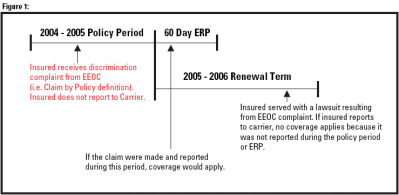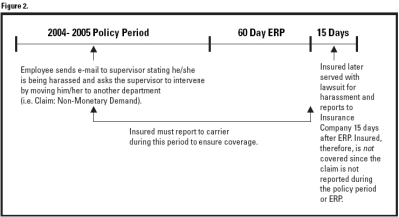Claims-made policies are policies commonly associated with professional liability policies, such as Directors & Officers, Employment Practices Liability and other miscellaneous professional liability policies including Lawyers Professional Liability.
A claims-made policy states that a claim must be made during the policy period or the extended reporting period (ERP), if applicable. Because no two policies are exactly the same, a basic knowledge of the claims-made policy, including the definition of a claim, the definition of a wrongful act and the claim reporting provisions, is essential to understanding this type of coverage.
However, this is not as simple as it sounds because there are ]two distinct types of claims-made forms. One is the “Claims-Made & Reported Form” and the other is the “Pure Claims-Made Form.”
“Claims-Made & Reported” form
The first and most widely used claims-made form today is the “Claims-Made & Reported Form.” This policy requires that the “claim” be made during the policy period or ERP, and reported during this same period of the policy currently in force at the time. A typical policy declaration page of this type may read: “This is a Claims-Made Policy. This Policy covers only those Claims first made and reported against the Insured during the Policy Period or ‘ERP,’ if applicable.”


The key words to look for are “… and Reported.” This is significant because it stipulates that it must be reported within a designated time frame.
“Pure Claims-Made” form
In contrast, the less commonly used “Pure Claims-Made” Form still requires that a claim be made during the policy period or the “ERP.” However, the major distinction between this form and the “claims-made and reported form” is that insured needs only report the claim “as soon as practicable,” or promptly, and not necessarily during the policy term which, in essence, can be anytime in the future. This form is more frequently used with directors and officers liability policy type policies.
A sample of this wording may read: “This is a claims-made policy which applies to ‘claims’ first made during the policy period or any extended reporting period.”
The difference between Claims Made & Reported vs. Pure Claims Made
While the differences of the policies seem subtle, not knowing those differences can have a dramatic impact on the coverage. Also, the answers may vary depending on the insurance company issuing the policy. In the professional liability insurance community, “claims-made” terminology is generically used whether it is a “claims-made and reported” form or a “pure claims-made” form. Don’t be misled! Many policies declare they are “Claims-Made,” when in reality, they are the “Claims-Made & Reported.” Some policy forms incorporate either bold wording on the declaration page or a statement within the insuring agreement proclaiming the policy is a “Claims-Made & Reported” policy.
Be careful–if this wording is absent, do not assume that the form is a “pure” claims-made form. You need to dig deeper into the policy and examine the “Notice of Claim” reporting provisions of the policy. This is where you will find additional reporting conditions and restrictions. If it is a “claims-made and reported” form, it will generally state that the claim must be reported within the policy period or another specific time frame, which can be as many as 60 days after the policy expiration. It is also important to point out that the “pure claims-made” form has no such restrictions.
The wording may read something like this: “The Insured shall, as a condition precedent to the obligations of the Company under this Policy, give written notice to the Company of any Claim made against the Insured as soon as practicable during the Policy Period. There shall be no coverage for any Claim reported to the Company later than 60 days after the expiration of this Policy or after the expiration of any applicable Extension Period.”
The wrongful act
The “wrongful act” starts the sequence of events that ultimately leads to a claim. A wrongful act is any actual or alleged error, omission or negligence committed by the named insured. However, the definition of wrongful act varies depending on the type of professional liability policy purchased. For example, the most common definition of “wrongful act” in an EPL policy includes “sexual harassment, discrimination or wrongful termination.”
Conversely, the definition of “wrongful act” in a D&O policy can be “any actual or alleged breach of duty, misstatements or misleading statements committed by the insured.” Therefore, the “Wrongful Act” serves as the “claim trigger” under a claims-made policy.
What is a claim?
Before an insured can report a claim, he or she needs to know what constitutes a claim. In many instances a claim may be defined as “an oral or written demand for monetary or non-monetary damages, including any judicial or administrative proceeding.” (It should be noted that not all policies utilize this exact wording.)
To gain a deeper understanding, we will look at a couple of examples relating to Employment Practices Liability claims.
Case 1:
During the policy period, the insured received a notice from the Equal Employment Opportunity Commission alleging “discrimination” (i.e. “a wrongful act”) by a former employee, and the insured does not report it to the carrier. By the policy definition, that notice (i.e. an administrative proceeding) would be considered a claim. Unfortunately, the insured may not realize that this would be deemed a claim because an actual lawsuit or demand was not filed against him or her. Therefore, the insured may not be compelled to report this to the carrier.
In that situation, if a lawsuit were filed against the insured after the policy expiration, after the ERP, if applicable, or even against a subsequent policy term, no coverage would be afforded because the notice by the EEOC served as the actual notice of claim, not the lawsuit recently filed. Conversely, if the insured reports the EEOC complaint during the policy period on the 60 day ERP in this case, coverage would apply. (See Figure 1.)
Case 2:
An employee of a furniture manufacturer was being sexually harassed by another employee. The harassed employee informed the supervisor of this incident via e-mail and asked for intervention (i.e. “non-monetary demand.”) The supervisor took an internal report, but did not report the claim to the insurance company during the policy period or 60 day ERP. Seventy-five days after the policy expired, the harassed employee files a lawsuit against the company and then reports the claim to the carrier.
Coverage was subsequently denied because the claim was not reported during the policy or ERP. In this case, the insured did not realize that the notice to the supervisor of the harassment actually served as notice of a claim under the definition of the policy because that was the claim trigger. (See Figure 2.)
A claim can only occur if a wrongful acts triggers coverage. In analyzing the previous scenarios, the allegations of discrimination and harassment were the wrongful acts that triggered the claims. Moreover, those wrongful acts could have occurred at any time in the past, even years before, provided it was not before any retroactive date imposed by the carrier and/or prior to the policy expiration.
Therefore, it is critical that the insured fully understands the definition of a “claim.” Thus, when a claim is triggered by a covered wrongful act, the insured can report the claim to the carrier appropriately and ensure more complete coverage.
Reporting a claim
Because of the stringent reporting requirements of claims-made policies, not knowing when or what to do when a claim arises can spell disaster for an insured.
It is the insured’s obligation to report a claim or a potential circumstance that could give rise to a claim to the carrier. While many insureds might be inclined initially to try to handle claims internally to avoid reporting to the carrier, the delay in reporting can easily be detrimental to the insured and put the coverage in jeopardy. Unlike other types of policies, professional liability polices are very explicit on how and where to report a claim. The reporting requirements cannot be stressed enough because failure to comply with the policy provisions can bar coverage for an insured. We encourage clients to report everything to protect their rights and allow us to handle the renewal negotiations.
In contrast, the “pure claims-made” form requires that the claim be reported promptly or as soon as practical. That, of course, is very subjective and, in theory, can be reported at any time in the future even after policy expiration. However, this is certainly not an advisable approach.
In addition to the “claims-made” issue, many policies provide an awareness provision that allows the insured the ability to report any incidents or circumstance the insured may become aware of that may lead to a future claim. That also has a window that states such notice must be given during the policy period.
When a circumstance is reported, it will be considered to have been reported during that policy period should it result in litigation after the policy has expired. Because each policy has a different reporting provision, it is important that the insured knows and understands his or her reporting requirement.
In the last hard market, at least one carrier introduced a “claims-sustained” policy. Although unique and rare, during the past 15 years, a number of both D&O and E&O underwriters have used “claims-sustained” policies. Those types of policies prohibit any notice of a claim other than actual litigation.
Each policy specifically outlines when and how claims need to be reported. While numerous carriers provide an automatic reporting period after the policy has expired, that period is normally limited to no more than 30 to 60 days.
It is also important to bear in mind that any extended reported period provided by the policy only extends the period in which a claim may be reported. The wrongful act must have occurred prior to the expiration of the policy. The insured needs to know that a claim should always be reported to the existing carrier providing the coverage at the time, not the carrier who was on risk when the wrongful acts were alleged to have occurred.
The only exception to this may be where a potential incident or circumstance was previously reported to a previous carrier.
Simply renewing with the incumbent carrier does not circumvent the need to report the claim within the policy term or applicable ERP. It is often assumed that if an insured renews with the same carrier, the reporting requirement continues into the next term.
This is a common misconception that should be addressed as part of any comprehensive renewal process. Keep in mind, unless the carrier has changed its form on the renewal (as some carriers had done during the hard market by replacing the claims-made form with more restrictive claims-made reported language), the policy wording will not usually change. Therefore, the reporting requirements will most likely remain the same unless notified by endorsement at the time of renewal.
While the pure claims-made policy is certainly the most advantageous claims-made form that provides the broadest reporting allowance, it is rarely used. Thus it is imperative that the insured becomes familiar with the claims-made and reported form, because it is more likely that this will be the policy he or she will need to know when a claim comes down the road.
Wayne E. Bernstein is director of professional lines for Monarch E & S Insurance Services, a managing general agent and wholesale broker. Phone: (805) 577-6800, Ext. 223. Email: wayneb@monarchexcess.com.
Was this article valuable?
Here are more articles you may enjoy.


 High-Net-Worth Risk Appetite Drops as Some Regions Show Stabilization
High-Net-Worth Risk Appetite Drops as Some Regions Show Stabilization  Longtime Motel 6 Spokesman Tom Bodett Settles Lawsuit Against Chain
Longtime Motel 6 Spokesman Tom Bodett Settles Lawsuit Against Chain  CRC Group Signs Agreement to Acquire Euclid Transactional
CRC Group Signs Agreement to Acquire Euclid Transactional  MAPFRE Accuses AAA of Violating Long-Time Exclusive Marketing Agreement
MAPFRE Accuses AAA of Violating Long-Time Exclusive Marketing Agreement 


